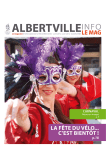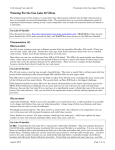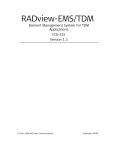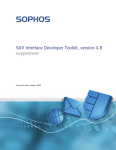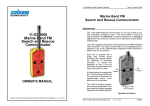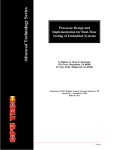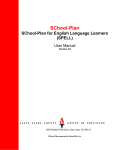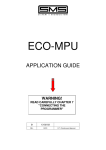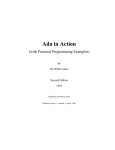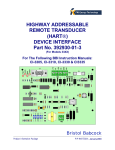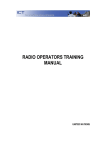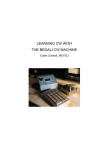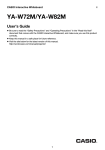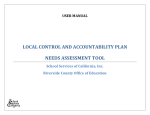Download Airwaves 12/07 - WA6YBN
Transcript
THE AIRWAVES December 2007 Sierra Amateur Radio Club An ARRL Special Service Club P O Box 1442 Ridgecrest California 93556-1442 BOARD OF OFFICERS President First VP Second VP Secretary Treasurer Gene Brewer John Andrus Fred Moses Lloyd Brubaker Pam Evans KI6LO KC6UWM KG6STR WA6KZV KC6UUS 446-1315 371-2190 371-4034 375-7245 375-4240 SARC OWNED AND MAINTAINED REPEATERS Randsburg Ridgecrest Ridgecrest Ridgecrest Ridgecrest Ridgecrest WA6YBN 145.34 MHz (-), PL 100.0 Hz, Wide Area, Emergency Power, linked to 147.00 WA6YBN 146.64 MHz (-), Translator, No Squelch Tail, Emergency Power WA6YBN 147.00 MHz (+), PL 107.2 Hz, Autopatch, linked to 145.34 YBNBBS:WA6YBN, 145.050 MHz, Bulletin Board, 1200 Baud #YBNSW:WA6YBN-4, 223.580 MHz, Node, 1200 Baud #YBNSW:WA6YBN-4, 439.025 MHz, Node, 9600 Baud SARC Committees Technical Assistance: Greg, WA7IRW 446-4383 Program: Fred, KG6STR 371-4034 RF Interference: Bill, WA6QYR 375-8566 Public Relations: John, KC6UWM 371-2190 Airwaves Editor: Mike, WA6ARA 375-5324 Emergency and Public Service: Mike, W6PM 793-0541 THE AIRWAVES CALENDAR Every ARRL Audio News 1910 (7:10 p.m.) on 146.64 MHz Monday Night AMATEUR RADIO LICENSE EXAMS Every Even Month, Second Saturday Dec 08 Volunteer License Exam Session Location: Guns 4 Us, basement classroom 417 East Ridgecrest Blvd, Ridgecrest CA No handicapped access Pre-reg by 3 Dec Limited to 8 applicant All must register at 9 AM Contact Elvy Hopkins NØLV 760-384-3589 E-mail <[email protected]> IWV Emergency Net Visitors Welcomed! 1930 hrs (7:30pm) WA6YBN Translator 146.64 MHz (-) East Kern County Emergency Net Visitors Welcomed! Rand repeater 145.340, pl 100 2000 hrs (8pm) From the President’s Shack Well it is finally cold here in the valley and the 2007 holiday season is upon us. How quickly it arrived. Seem just yesterday it was the middle of summer and everyone was on vacation. I hope everyone had a very Happy Thanksgiving time with family and friends. I'm still eating turkey leftovers, hihi. As the Christmas season is quickly approaching, I would like to take this opportunity to wish everyone a Merry Christmas and prosperity into the New Year. I'm sure you have all been extremely good boys and girls and have taken the time to write to that 'special' Santa with your wish list for this year. I know I sent mine. Dec 12 SARC Board Meeting 7 pm – Heritage Inn Conference Room Dec 12 SARC General Meeting 730 pm – Heritage Inn Conference Room Program – "Building a TiniCat radio / computer interface kit", and a few examples of home brewed antenna components. Jan 9 SARC Installation Dinner 630 pm – Casey's Steak and BBQ While we are setting about to prepare for feasting and festivities related to our Christmas with family and friends, let us not forget the less fortunate in our Jan 26 Fire Mountain 50 Horse Ride Contact Bill WA6QYR 375-8566 to volunteer. 1 community. Although Ridgecrest is noted for it's higher than average per capita income (lot's of very smart educated people live and work in this area), there are those here who may not be so fortunate as the mainstream populace and may be needing a helping hand this year. Let us, first as fellow human beings and secondly as amateur radio operators who care, try and help out when and where you can. It may be as little as a few dollars in the Salvation Army pot at Wal-Mart to as much as a full blown Christmas dinner and some presents for the family down the street that has little due to whatever reason. The reason they are without this year isn't important but helping out is. Let your compassion be your guide and help where you can. Greg, WA7IRW talked about his new projects; a tilt over crank up tower on the back of his RV, the ARRL Frequency Measurement Test that occurred earlier that evening and how to get your radio calibrated to participate, and a discussion of tools to build that chassis of your project. Dennis, W6DWF had a mount for the control head placement with in your car. Hal, KM6JM talked about his construction of a 2-meter antenna on a house window based up on a QST Hints and Kinks June 1988. As most of you know I am not going to be running for club president this next year but I plan on remaining active in the club. If you would like to volunteer to run as president (or any office for that matter), please let the club know so you can be included in the nominations. We've had a great and fun year and let's all try to make the 2008 year a great one too. Get involved more if you haven't been lately. If you have been wanting to upgrade, go for it. The club can help. Let us know how we can. Remember it is YOUR club and it's here for YOU. Jerry, KK6PA talked about the Hospital drill earlier in the day using Airmail software on packet. Participants include Jerry KK6PA, Bill WA6QYR, Greg WA7IRW, Dennis WA6DWF and Mike W6PM. See you all at the club meeting, Treasurer's Report as of 01 December, 2007: Draft Account $ 124.25 Share Account $ 4,718.02 BALANCE: $4,842.27 submitted by Pam Evans, KC6UUS Bill, WA6QYR won the 50-50 drawing of $16.50. Submitted Bill Burns, WA6QYR TREASURER'S REPORT Gene KI6LO November Meeting Minutes Minutes for 14 Nov 2007 SARC meeting SARC Installation Dinner The annual SARC Installation Dinner will be held on Wednesday, 09 January at Casey's BBQ, 1400 N. Norma. There will be good times, good food and lots of prizes, including a grand prize of a MFJ 259B SWR Analyzer, and a whole lot more. President Gene, KI6LO at 7:32, opened meeting Ralph Frazer was the seldom seen member in attendance. No visitors present. Up coming events include OTHTC run on 2 Dec. Mike, WA6ARA is the point of contact. The Amazing WA7IRW RV Mast 20 Mule Team and Fire Mountain 50 are horse rides coming up after the first of the year. For those interested in the source article, check the Public Service Dept. in QST Feb 2005 pp 87-88, or see on-line at Installation dinner is to be at Casey's Stake House on 9 January 2008. http://www.arrl.org/news/features/2005/01/06/1/ Owens Valley Repeaters Bill, WA6QYR volunteered to head the nomination committee needing to find replacements for the 2nd VP in charge of Programs and a President. Gene, KI6LO is to provide a SARC membership list to work from. Paula, N6VGW volunteered for Secretary. Mike, WA6ARA and John, KC6UWM volunteered to collect prizes up to $500 as voted by the membership present. Here is the update on the SIARA Repeaters. Before Terry Downey passed away, he asked Rich, KF6YLW, and Kurt, W6PH, to take over custody of the Owens Valley repeaters that had been part of the Gronk Network. His intent was for these repeaters to be open for all amateurs to use. Originally, there was a link out of the valley but it was lost about a year ago. We formed the Southern Inyo ARA to replace LIARS for the express purpose of maintaining and ensuring that the repeaters would be available for all amateurs as well as a resource in the event of an emergency in the Owens Valley. Terry's widow gave us permission to apply to the FCC for There was discussion of a License learning class some time after the first of the year. Mike, WA6ARA; Fred, KG6STR; Dennis, W6DWF; and Gene, KI6LO volunteered to be on the committee to set it up and Hal, KM6JM volunteered to be an instructor. 2 Terry's call sign which we have done. The ID on the VHF and UHF repeaters is W6TD. During the past six months, the club has expended about $1000 reinstalling the Little Lake repeaters, for controller replacement on Mazourka, and upgrading the Mazourka Power Company. None of this would have happened if it had not been for the technical expertise of Dennis, W6IY, and Ted, AE6YM. There were many technical challenges some of which still exist. Presently, the VHF system consists of the Mazourka 146.76- linked to Little Lake 147.21+ giving coverage from north of Bishop into Ridgecrest. The UHF system consists of Silver Peak 444.4+ (PL 131.8) linked to Mazourka 442.3+ (PL 131.8) linked to Little Lake 447.16- (PL 131.8) giving essentially the same coverage as the VHF system. The Mazourka and Little Lake sites are under the custody of SIARA and the Silver Peak repeater is a tenant in the BARC site. We encourage the use of these open repeaters by everyone in the Owens Valley and Indian Wells Valley. Submitted by Kurt, W6PH SPLIT mode – The What, Why and When This topic is always popping up on DX forums on the internet by newbies unsure of what it is all about. This is one of the first and foremost transceiver options that will be required for success in many DX’ing situations. The term ‘SPLIT’ refers to a method of transmitting (TX) and receiving (RX) on different frequencies. Many DX stations use this method to prevent the noise from a PILEUP (many hams trying to contact the DX station at once) from covering up their signals. Many DX stations do not run large amounts of power therefore their signals can easily be lost in a pileup. By separating their TX frequency from their RX frequency, they can manage the pileup easier and reduce QRM. Also some use it to allow operations between hams limited by frequency allocation differences. In all honesty, you can work DX without the ability to work SPLIT, but you will miss out on many good opportunities. In order to be able to work SPLIT, your transceiver will need to have two separate VFOs (variable frequency oscillators, or aka ‘the big knob’). Almost all modern transceiver have these. However should you be the owner of one of the great classic radios that are still available as prime used gear, then an optional piece of equipment, the external VFO, maybe needed? Fret not, because just as the classic radio’s value is lower than a new rig, so is many of its options. The problem lies in finding these options. But that will be a fun task for you to pursue and is not part of the column here. Suffice to say that if your radio has SPLIT mode capability, then there will be buttons or switches to enable it. I refer you to the owner’s manual for clarification on where these are located. OTHTC ULTRAMARATHON Dual VFO are usually identified by labels on the front panel or display as ‘VFO-A’ and ‘VFO-B’. Which one is used for TX and which one is for RX does not matter because when the transceiver is placed in ‘SPLIT’ mode, the current VFO will be RX and the other will be TX. This is what SPLIT mode is for. Let’s take a look at a generic SPLIT setup. Please note, except for pro-signs and abbreviations, the methods described in the following sections will work for any mode (CW, SSB, RTTY, etc) when operating SPLIT. On the second of December, SARC volunteers supplied communications for the Over The Hill Track Club Ultra Marathon. Working the race / run was Larry KI6KNX, Dennis W6DWF, Tim NH2BV, Fred KG6STR, Greg WA7IRW and Mike WA6ARA. Special thanks to Greg WA7IRW for once again setting up the portable repeater, sure makes the task of communications a whole lot easier. There were approximately 350 runners this year, bigger than the last couple. This is always an interesting exercise, if everything goes well, there is little to do, but, if not, then we can be very, very busy. This year was an easy one, with just keeping track of who is running and who is not. Imagine if you will you are tuning around and come across a DX station who is calling “CQ stateside” followed by ‘listening up 10’. You’d like to QSO this DX station and get a QSL card, but what does all this mean? Well the first part is obvious; he is calling ‘CQ stateside’ to contact any US amateurs. But what about the ‘listening up 10’ part? This is an indication that the DX station is working SPLIT mode and is listening for replies to their CQ call 10 kHz higher than the TX frequency that you are listening on. DX’ing from the IWV Welcome to the 2nd edition of the DX column for IWV / SARC DX’ers. I hope you found the 1st edition (Nov 2007 AIRWAVES) useful and interesting. To carry on with the theme of ‘Starting Out in DX’ing’, this month we’ll be discussing a important tenet of DX’ing, ‘How to work SPLIT’. Each month we’ll be covering more topics geared to make you a better DX’er. Let’s take a second to look at the front panel of your transceiver. Assuming you have a standard transceiver that has one ‘big knob’ for tuning and features dual VFOs, you should be able to locate the following three 3 buttons: the SPLIT mode button, VFO A/B selection button and the VFO A=B button. These three buttons are going to be used to setup your transceiver to allow you too hopefully (after all, DX’ing is a game of chance) contact the DX station and get the QSO in the log for a QSL card. Now think for a minute to see if you can visualize the process on your own. Don’t press anything yet …. Did you visualize the process? It shouldn’t be difficult if you think about it. If not, then let’s go through it. to the alternate VFO (in this case, VFO B) for TX and back to the current VFO (VFO A) upon RX. If you have done everything correctly, you should see the indicator on the display toggle ‘VFO A’ to ‘VFO B’ when keying the microphone or closing the key (for you CW ops) for TX. Step 1: First, let’s assume that your radio is setup to RX on VFO A and is tuned to the DX station’s TX frequency. You’re listening to him on VFO A. Now, lets setup for calling him ‘10 kHz UP’. The first thing you would do is press the ‘VFO A=B’ button. This will assign the frequency of ‘VFO A’ to ‘VFO B’ (VFO A = VFO B). This gets the VFO B frequency ‘in the ballpark’ for tuning to your TX frequency. Ok, still with me? Great, let’s go to the next step. IMPORTANT RULE NUMBER 2 Remember nothing we have described above controls the antenna being tuned/used nor how the radio being configured for proper transmit levels. You have simply set up the VFOs to operate SPLIT mode. When you are finished with the SPLIT mode QSO, press the SPLIT mode button to OFF. If you don’t……. look out. Remember the FREQUENCY COPS. They’ll be back while you’re scratching your head trying to figure out what’s going on. Please note that you could have just as easily setup VFO B to be the RX and VFO A to be TX. It makes no matter which way so long as the SPLIT mode is ON, the VFO’s will toggle RX to TX and back RX. The preceding steps work on any radio (with 2 VFO’s and one BIG KNOB), any mode and any frequencies. If you have a newer radio that actually has 2 VFO tuning knobs and 2 VFO displays, then you won’t need to do the steps of VFO A/B to switch back and forth between the VFOs to tune them. There is probably a control that assigns which VFO is RX and TX and you’ll use that instead but the procedure described above will work in 95% of the cases I’m fairly certain. Step 2: Press the ‘VFO A/B’ button. This will switch over to the ‘VFO B’ for tuning. Assuming you only have one VFO tuning display, the VFO indicator should show ‘VFO B’, indicating you are using the VFO B and the displayed frequency should have not change from that displayed for VFO A (remember VFO A=VFO B). If all is ok, then go to step 3, otherwise if the frequency did change, press the ‘VFO A/B’ button again to select VFO A and go back to Step 1. If it still did not work, then I will refer you to your user’s manual to determine what extra steps may be needed. Step 3: Turn the VFO tuning knob and set the VFO B frequency displayed to 10 kHz higher than the current reading. This will be your TX frequency and the DX station’s RX frequency. Note: you will not hear the DX station now but you may hear other stations calling the DX station on this frequency. You are now listening to ‘the pileup’ (assuming there is one – if your lucky, there may not be one YET). Common mistakes to watch for when operating SPLIT mode (keep those FREQ COPS at bay): >Out of band transmissions when in SPLIT => Many DX stations do not have the same frequency allocations as US hams so SPLIT mode allows us to QSO them >Reversing the TX and RX VFOs => Speaks for itself – you’ll TX on the DX TX frequency and make lots of friends ☺ >Forgetting to turn SPLIT ON or OFF => Again, forgetting this will earn you the wrath of many DX ops waiting their turn to QSO! Step 4: Press the ‘VFO A/B’ button again to switch back to the VFO A frequency. The display indicator should show ‘VFO A’ and the frequency should change back to the original VFO A value. You should now hear the DX station again on this VFO frequency. Just to make you feel in good company, the author recently violated IMPORTANT RULE #1 and instantly was reprimanded by the resident FREQ COP. So see, it happens to everyone now and then. Your VFO’s are setup now but there is still one more step before you call the DX station. This is probably the most important step because if you forget to do it (and everyone does from time to time), not only will you be on the wrong frequency when you transmit, but you may incur the wrath of the dreaded ‘FREQUENCY COPS’. These are bozos whose life calling is to scan the bands looking for someone making a mistake like transmitting on the wrong VFO. They will let you know about it in no uncertain terms while they cause more harm than you did with an honest mistake. Just ignore them for what they are. Well until next time, good DX’ing and remember to be courteous to your fellow DX’er. Gene - KI6LO [email protected] FOR SALE U. S. Tower Model TS-455, 60 foot, three section, free standing, crank up tower. Still in use. You take down (raise/lower fixture available) and haul, $1,000. Two (one in tower) 98 ball, Ham II/III/IV CDE/HyGain antenna rotors with control boxes. Kenwood TS-450 xceiver +pwr Step 5: (Important Rule number 1) Press the SPLIT mode button to ON. This will cause the radio to switch 4 sup. MFJ antenna tuner. Miscellaneous antenna parts/pieces/thinga-ma-bobs. Chuck Freeland KC6LOJ 377-5163 career at the telephone company. They had three children and still lived in the very house they'd bought brand new as a young couple in 1947. Tom was a tinkerer, and he'd built several transmitters and even a few receivers. But he was a serious brasspounder and could handle 30 to 40 WPM with ease. His station was always as clean as his signal, and any piece of equipment he built was a work of art. It wasn't good enough just to work and look good--it had to be perfect. Other members of the local radio club poked fun because Tom had a habit of making sure that even the screw slots on anything he built were aligned in the same direction. He didn't buy his first commercially made gear until 1961--a Hallicrafters SX-140 receiver with a matching HT-40 transmitter. That was the only store-bought equipment in his shack until over a decade later, when his best friend died suddenly. His friend's widow gave Tom all the equipment in her husband's shack, including a complete Collins S-Line. That gear took a special place in Tom's heart and shack, not so much because it was the "ultimate station," but because it had belonged to his closest friend. After retiring in 1986, Tom quit building equipment. He maintained several skeds with on-air friends from around the world. Saturday nights were his favorite, for it was then that he met with a large number of old Navy radio ops on 7.030. He really enjoyed those rag chews! But, one-by-one, the gang started to dwindle as more and more of his buddies became Silent Keys. It depressed him so that when his main receiver quit working in 1993, he didn't bother to fix it. K9NZQ was off the air for the first time since World War II. Stella was worried enough about her husband's depression that she told the kids about the problem. They chipped in and bought him a brand new 2-meter FM radio for his birthday thinking that would cheer him up. Tom listened to the local repeater every day, but he rarely transmitted. It just wasn't the same. She had hoped that having all the kids and grandchildren at the house again this Christmas would perk Tom up and chase away the lingering blues but now the weather had ruined that plan. "I think I'll go out and make sure the generator still starts," he said as he passed through the kitchen. "The power lines are beginning to ice up." Once he was out the back door, Stella took the opportunity to quickly and carefully wrap her gift to him. One of his friends had suggested to her that she buy Tom a kit for Christmas. Taking his suggestion, she ordered a small QRP CW transceiver kit he'd recommended. She didn't know if he would like it, but with this weather she was especially glad it had a arrived a few days earlier. Like it or not, at least he would have something to open on Christmas morning. Day turned into evening and somehow the power stayed on. More snow was falling outside. The TV was calling it some sort of record snowfall for central Indiana. When Tom said he was going to bed and it was only 6:30 PM, she decided it was time. "Let's go ahead and open our presents now, and not wait two more days" she said, handing him the gaily wrapped box. He didn't really want to open presents, now but he A QRP Christmas By Jeff Davis, KE9V "A foot of new snow and it's still falling, this is getting bad," Tom muttered to no one in particular. Just then Stella walked in with a sad look on her face and Tom knew right away. "The kids aren't going to make it, are they?" he asked. "No," she answered, "I just got off the phone with them and the roads are all closed." Great! Two days before Christmas, and the world had come to a halt. Tom gave his wife a hug and said, "Well Mother, we might as well get over it, nothing much we can do now but wait this thing out." In the 50 plus years since the couple bought the house they had weathered many winter storms, but this would be the first Christmas without the kids and, now, the grandchildren. Nature could be cruel, but at least they had plenty of food and firewood, and there was ample gas for the generator in case the power went off. "I think I'll go see if the repeater is still on the air," Tom said as he headed to his ham shack over the garage. Being a radio amateur had its advantages, and emergency communication was one of them. He fired up the VHF set, and--sure enough--the local repeater was alive and busy. Several folks in the community needed assistance, and snowmobile deliveries were being organized accompanied by hams to maintain communication. As with many things, people take communication systems for granted until they're suddenly unavailable. Two years earlier, with the proliferation of cellular telephone technology, Middletown decided it no longer needed Amateur Radio to assist during emergencies. A few months later, the river overflowed its banks during a massive rainstorm. Lightning wreaked havoc on the power grid and even cellular telephones were overloaded or knocked out altogether. With one loud clap of thunder Amateur Radio was back in the disaster communications business in Middletown. The Town Council went so far as to give the Middletown Amateur Radio Club access to a county building to serve as a communications headquarters and monthly meeting spot. Stella walked up the stairs to the radio shack with a hot cup of coffee for Tom. She figured he'd be spending quite a lot of time on the air during this snow emergency. She was wrong. Tom wasn't all that fond of 2-meters, really. He'd always been a CW op. In fact, for years he never even owned a microphone for his HF gear. To him, ham radio was and would always be, CW. His high school print shop teacher had convinced him to get his ham license in 1939. A few years later, Uncle Sam took note of his radiotelegraphy talents and made him a Navy radio operator aboard the USS Missouri. He served from 1941 until the end of the War and even was present aboard the Missouri for the formal Japanese surrender. Not long after the War, he married his high school sweetheart, Stella, and started what would be a 40-year 5 didn't want to disappoint Stella, knowing that she was still upset about the kids. "All right, let me go get yours first," he agreed. In a few minutes they were opening their presents. She seemed to really like the bread making machine. He was more than a little surprised as he opened the little QRP kit. "There now," she allowed, "that will give you something to do for a few days and it will keep you out of my kitchen." Tom knew he'd been underfoot lately. "You're sending me to my room without pie?" he said with a smile. "Go on with you. I'll bring pie up to you as soon as the coffee quits brewing," she said as he headed back to the shack with the little box in hand. By the time she walked in the shack, pumpkin pie in one hand and hot coffee in the other, Tom had unpacked the box, sorted the parts and was halfway through the instructions. She was happy to see he at least looked interested and left the room with her fingers crossed that this might cheer him up. He didn't leave the shack until nearly midnight. By then, he had half of the components soldered to the main board, and he had wound several coils. "If the power doesn't go out," he muttered, "I could have this thing running by Christmas!" The next morning he awoke at 7:30 AM, two hours later than usual. Stella already had the bacon frying when he walked into the kitchen. A quick look out the back window revealed yet another foot of fresh snow had fallen last night. He was glad to see blue sky and sunshine and hoped that meant the worst was over. After breakfast he was back in the shack, soldering pen in hand. Tom was genuinely impressed with the little kit. The instructions were clear, and it looked to be of highquality. He had already convinced himself, though, that he would never make a contact on 40 meters with less than 3 W. Nonetheless, he was happy to have something to keep his hands and mind busy. And it was a good thing that he'd kept up that dipole so he could see if this radio actually worked. By 7 that evening, the kit was nearly finished. He was ready to apply power and begin initial testing. Stella knew that her decision to buy the little kit was a good one when he asked if she'd mind if he ate supper in the shack. By 11 PM Christmas Eve, the kit was finished. He plugged in the headphones, hooked up the antenna connection, and applied power. The noise level jumped, and he knew things were working when he moved the VFO ever so slightly and instantly heard a QSO in progress. "Now, that's a good sign," he said to himself. He pulled off the headphones and headed upstairs to tell Stella the good news. But she was fast asleep. It was midnight. No point in waking her up now. He slipped back to the shack and put the headphones back on. 73 ES MERRY XMAS OM DE W5WBL he heard as one QSO completed. Tom moved a little higher in the band until he heard a strong station in QSO with a VE6 in Vancouver. He was more than a little impressed with the sensitivity of the receiver. After listening to a few more QSOs he continued moving up the band until suddenly, he heard a familiar call sign. CQ CQ CQ de XE3HHH XE3HHH XE3HHH K. Tom almost couldn't believe it. Here was his old friend Miguel in Mexico calling CQ. He listened as Miguel called several more times with no reply. Thinking it silly to even try, Tom grabbed an old straight key and plugged it in. It was the first time in years that he had even touched a key. "This will never work" he thought as he tapped out XE3HHH XE3HHH XE3HHH de K9NZQ K9NZQ HW CPI OM? Tom's jaw dropped when almost instantly Miguel came back. K9NZQ de XE3HHH FB OM I THOUGHT YOU DIED HI HI MERRY CHRISTMAS AMIGO. The two chatted for nearly an hour until Miguel had to go. After the final 73, Tom sat back in his chair and rubbed his chin. He couldn't help but smile when he thought of just how much fun this day had been. Building the little kit and actually working an old friend just seemed to make his day complete. He would have bet half his retirement pension that there was no way to work Miguel with less than 3 watts. He knew some guys who worked QRP regularly, but he had always assumed that actually making contacts was a pretty rough and risky business. At least he never thought it would be that easy. He was about to shut down the rig and go to bed when he heard a loud CQ just off the frequency where he worked Miguel. It was KL7DD. Tom reached for the key figuring he'd get in another quick QSO--or at least make the attempt--then go to bed. KL7DD turned out to be Joe in Point Barrow, Alaska. Joe also was ex-Navy, so the two hit it off right away. What started off to be a "quick" contact turned into a two-hour QSO. Joe only had trouble hearing Tom a couple of times. The little QRP rig was holding its own and making a believer out of Tom in the process. Four contacts later, Tom was exhausted. About the time he shut things down and headed for bed, Stella walked in. "Merry Christmas!" she exclaimed. "What time did you get up? I didn't hear you get out of bed?" Tom wasn't sure how to tell her he had been up all night 'playing radio' so he just replied, "early." "Well, I've got breakfast ready," she said as she walked back down the stairs. He was still thinking about the contacts he made last night when he sat down at the kitchen table. "You know Mother," he said with a smile, "this might have been one of the very best Christmas's we've had in a long, long time. After breakfast, let's call the kids, but then I need to be back in the shack by noon because I told a guy that I would meet him on 40 meters to help him check out his new antenna..." No doubt about it. K9NZQ was radio active once again. Reprinted with permission from the author, Jeff Davis KE9V 6 MEMBERSHIP APPLICATION SIERRA AMATEUR RADIO CLUB of the HIGH MOJAVE Please fill out this form. It is used to make the club roster and newsletter mailing list. This form must accompany all membership, badge and patch payments. All renewals are due 1 January. Memberships not renewed by 31 March are dropped from the membership role. Please mail this application and your payment to SARC, POB 1442, Ridgecrest, CA 93556-1442 or give them to the Secretary at a meeting. New or Renewal $20.00 $17.00 $10.00 $30.00 $27.00 Type of membership Individual Individual (Newsletter via Email only) Full time student or active duty military Family (One Newsletter) Family (One Newsletter, via Email only) July - December $3.00 + $1.50/mo. $3.00 + $1.50/mo. $1.50 + $0.75/mo. $4.50 + $2.25/mo. $4.50 + $2.25/mo. Date ______________________ Individual or First Family Member Name: Last__________________________ First______________________ MI_____ Call Sign_______________ Newsletter Format Printed via mail ____ Email PDF ____ Email Plain Text _____ E-Mail Address______________________________________ (Note: Email address is not shared, for newsletter only) Mailing address: ________________________ City__________________________ State________________________ Zip______________________ Phone: Home______________ Work________________ License Expire Date_________ Novice___ Tech___ Tech Plus___ Gen___ Adv___ Ex___ ARRL Member : Yes _____ No ______ Second Family Member (For more family members please duplicate) Name: Last__________________________ First______________________ MI_____ Phone: Home______________ Work________________ License Expire Date_________ Novice___ Tech___ Tech Plus___ Gen___ Adv___ Ex___ ARRL Member : Yes _____ No ______ TOTAL $_______________ _________________________________________________________________________________________________ DO NOT DETACH BADGE ORDER DO NOT DETACH The club badge shows your Amateur Call, your Name and Sierra Amateur Radio Club. It will identify you at club meetings and public service events. To order a badge, provide the information below and, include $11.00, for each badge in Membership Application total above or with this form and mail to SARC, POB 1442, Ridgecrest, CA 93556-1442 or give it to the Treasurer at a meeting. First Badge Name to put on my badge is_____________________ (What you like to be called) Amateur call for my badge is____________________ Second Badge Name to put on my badge is_____________________ (What you like to be called) Amateur call for my badge is____________________ 7 THE AIRWAVES NEWSLETTER December 2007 RACES, ARES and INDIAN WELLS VALLEY EMERGENCY NET MEMBERS In case of impending or current emergency, monitor the SARC translator on 146.64/04 MHz or the backup simplex frequency of 146.52 MHz. W6PM, Mike or AI6A, John, the local RACES ECs, will coordinate mobilization. An Emergency Net Control Station will direct radio communications. Check in. State your capabilities. Be prepared to go outside the IWV for at least three days. An E-Pac should contain: your RACES card, radios and accessories, batteries, charger, paper, pen, clipboard, flashlight with spare batteries, timepiece, headgear, sunglasses, spare glasses, your medications, your medical history, first aid kit, severe weather clothing, non-perishable food, 3 gal. water, sleeping bag. SIERRA AMATEUR RADIO CLUB POST OFFICE BOX 1442 RIDGECREST, CA 93556-1442 8









